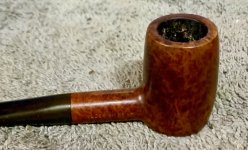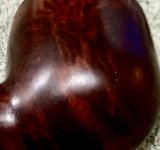Sap is not a precise word.
But it’s the best word I know to use.
Legend holds that a visiting nobleman to Italy broke his meerschaum and while it was being repaired a craftsman fashioned him a briar pipe made of a Heather burl.
He said wow, this is a good pipe.
And thereby man’s love affair with briar pipes was born.
But what’s the best briar?
The best briar is pretty. It has fancy grain.
It’s also fireproof and tastes good.
The sap inside the burls of the heather shrubs that grow around the Mediterranean tastes the best.
And the worse soil those burls grew, the slower they grew and the tighter the grain, and the more of that good tasting sap there was.
The pipe makers figured all this out a long, long time ago.
View attachment 276642
There was some really poor soil in very severe weather conditions in Greece and Albania that KB&B took all the really ancient burls from in the thirties. Those are pretty as pretty gets, and they are divine smokers.
But the prize briar came from the Atlas mountain range in North Africa in Algeria. Some of it was over 400 years old. Some tiny portion of that was also pretty.
All those truly ancient Algerian briar burls are gone, gone even before the 1954 revolution. We smoke second best today.
The sap (or whatever the goodie is inside 400+ year old Algerian briar) is incredibly good tasting.
Once you get one you’ll know.
View attachment 276653
But it’s the best word I know to use.
Legend holds that a visiting nobleman to Italy broke his meerschaum and while it was being repaired a craftsman fashioned him a briar pipe made of a Heather burl.
He said wow, this is a good pipe.
And thereby man’s love affair with briar pipes was born.
But what’s the best briar?
The best briar is pretty. It has fancy grain.
It’s also fireproof and tastes good.
The sap inside the burls of the heather shrubs that grow around the Mediterranean tastes the best.
And the worse soil those burls grew, the slower they grew and the tighter the grain, and the more of that good tasting sap there was.
The pipe makers figured all this out a long, long time ago.
View attachment 276642
There was some really poor soil in very severe weather conditions in Greece and Albania that KB&B took all the really ancient burls from in the thirties. Those are pretty as pretty gets, and they are divine smokers.
But the prize briar came from the Atlas mountain range in North Africa in Algeria. Some of it was over 400 years old. Some tiny portion of that was also pretty.
All those truly ancient Algerian briar burls are gone, gone even before the 1954 revolution. We smoke second best today.
The sap (or whatever the goodie is inside 400+ year old Algerian briar) is incredibly good tasting.
Once you get one you’ll know.
View attachment 276653
Last edited by a moderator:






















